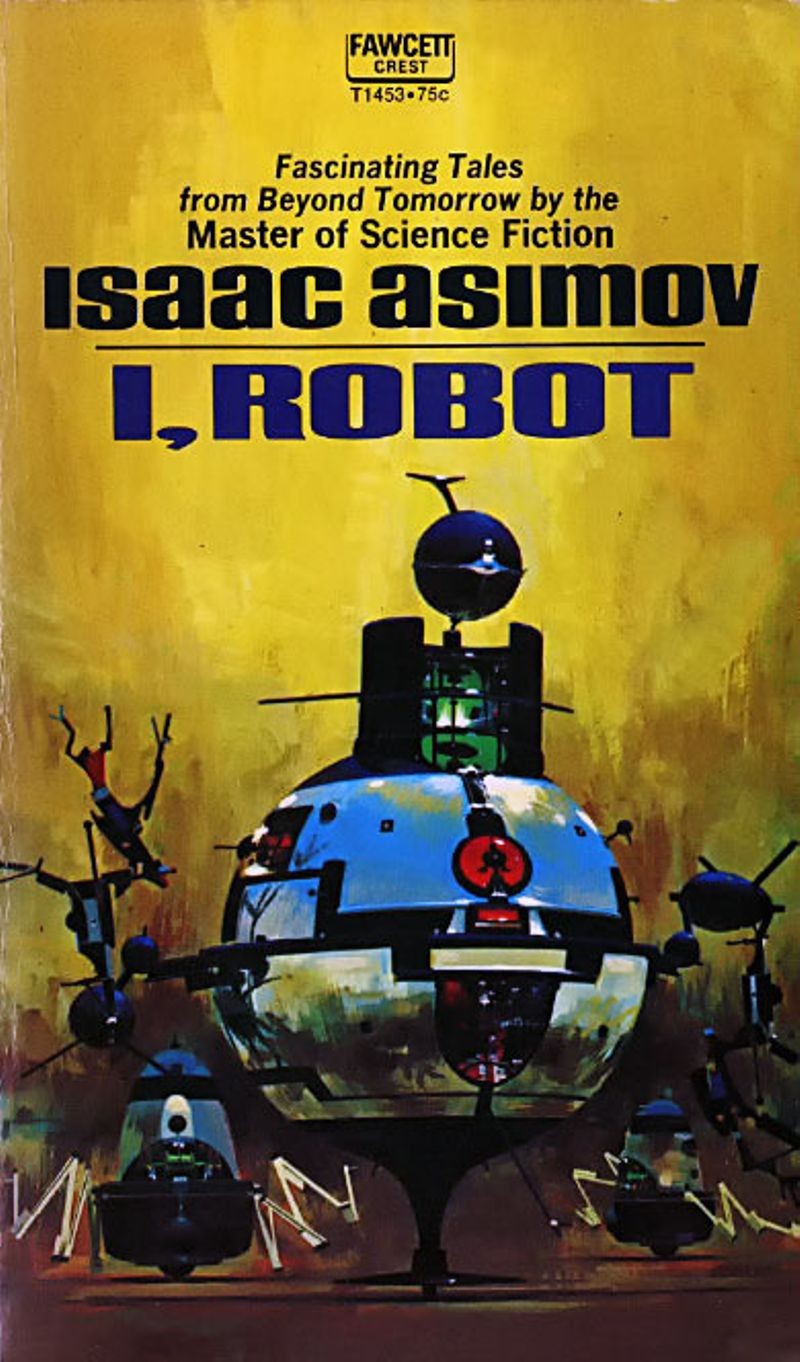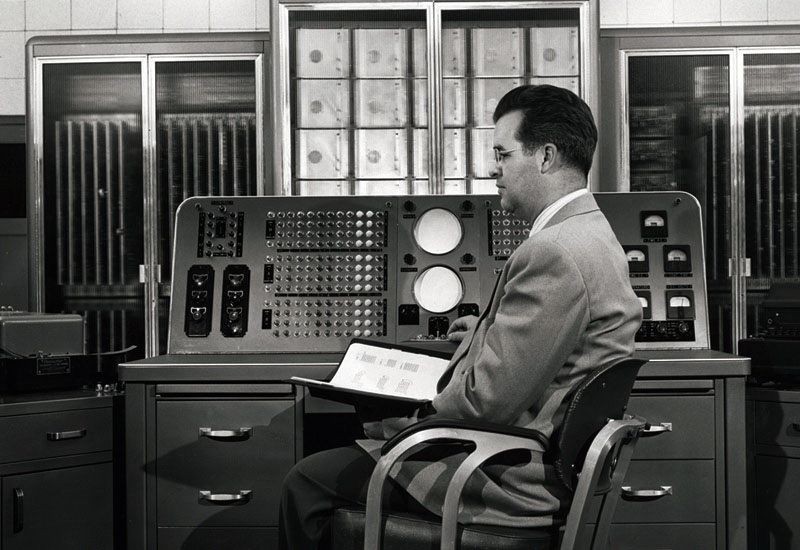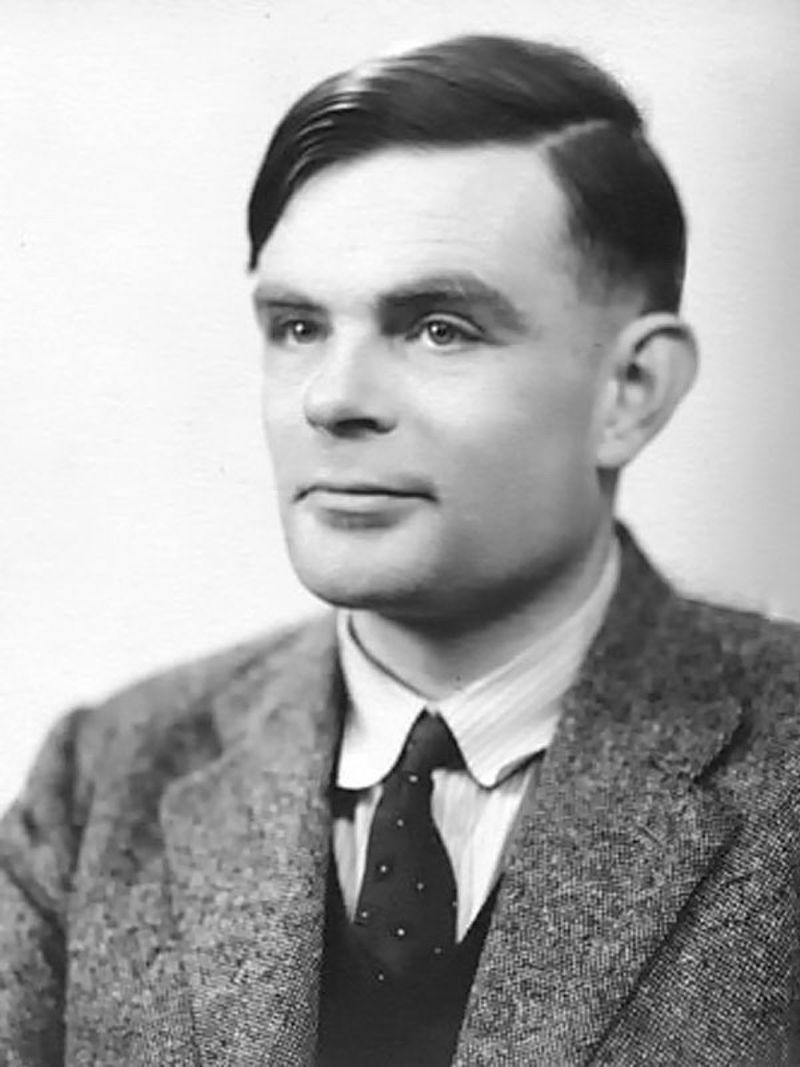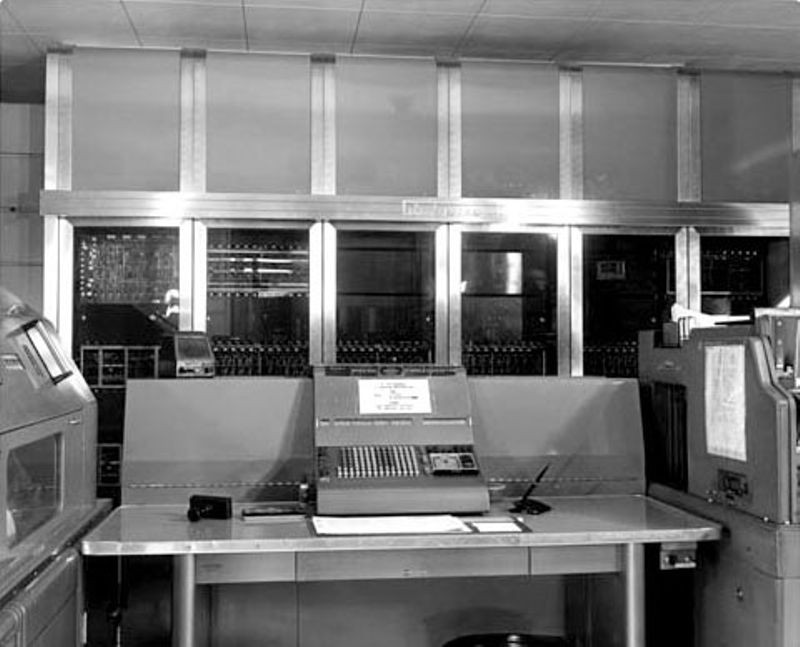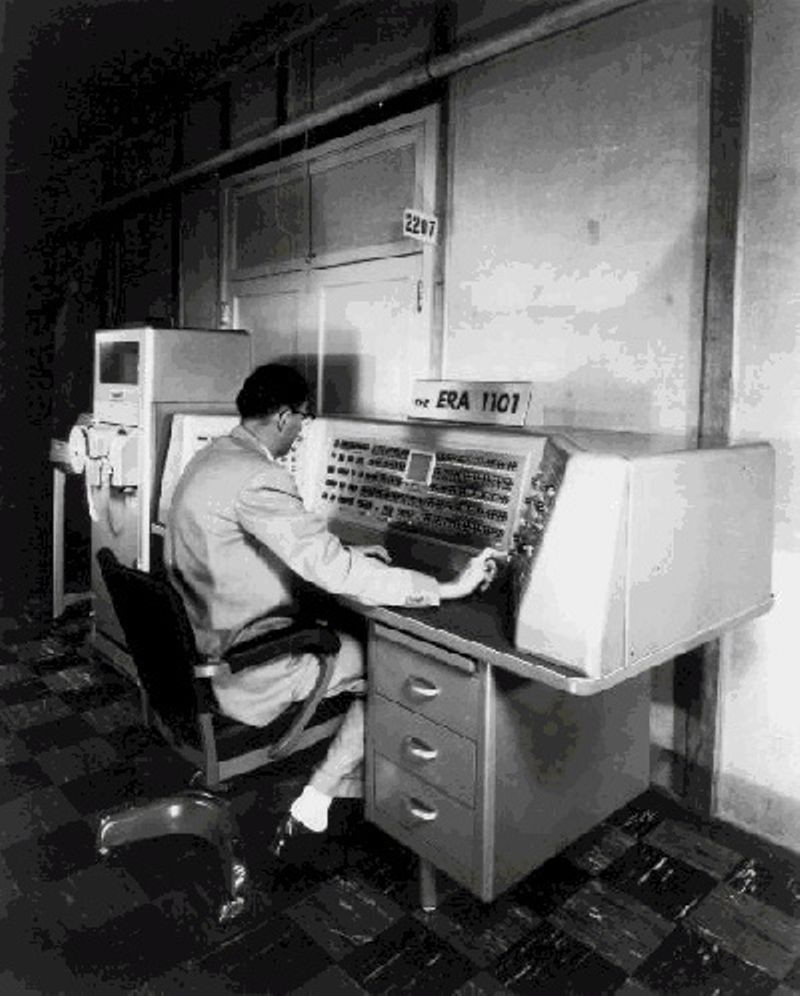
ERA 1101
ERA 1101 introduced
One of the first commercially produced computers, the company´s first customer was the US Navy. The 1101, designed by ERA but built by Remington-Rand, was intended for high-speed computing and stored 1 million bits on its magnetic drum, one of the earliest magnetic storage devices and a technology which ERA had done much to perfect in its own laboratories. Many of the 1101’s basic architectural details were used again in later Remington-Rand computers until the 1960s.
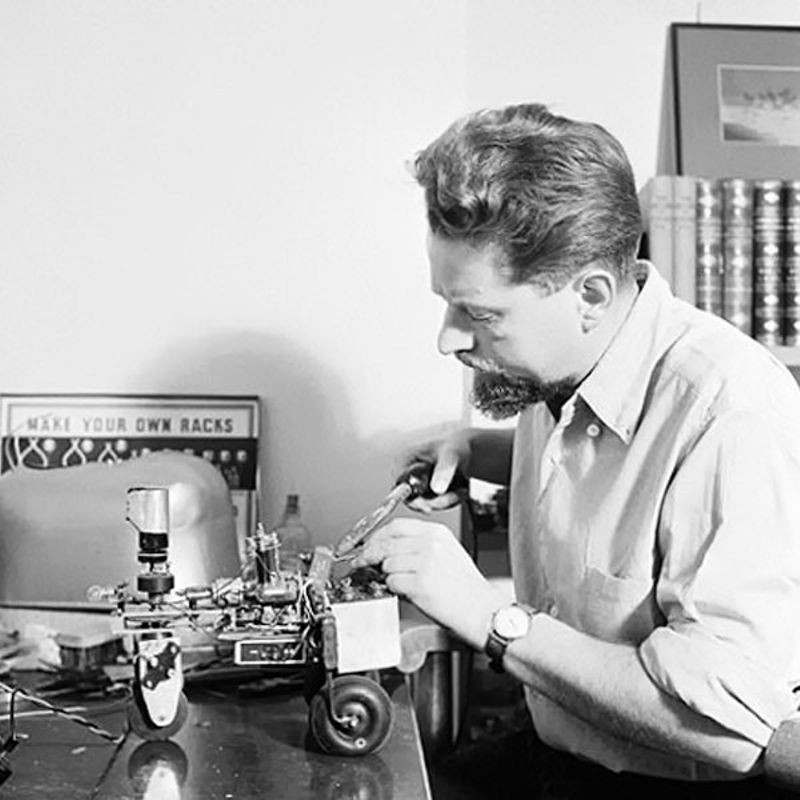
Grey Walter working with Elsie
Grey Walter’s Elsie
A neurophysiologist, Walter built wheeled automatons in order to experiment with goal-seeking behavior. His best known robot, Elsie, used photoelectric cells to seek moderate light while avoiding both strong light and darkness—which made it peculiarly attracted to women’s stockings.
I, Robot book cover
Isaac Asimov’s I, Robot
Isaac Asimov’s I, Robot is published. Perhaps in reaction to earlier dangerous fictional robots, Asimov’s creations must obey the “Three Laws of Robotics” (1941) to assure they are no threat to humans or each other. The book consisted of nine science fiction short stories.

ERA founders with various magnetic drum memories
Magnetic drum memory
Eager to enhance America’s codebreaking capabilities, the US Navy contracts with Engineering Research Associates (ERA) for a stored program computer. The result was Atlas, completed in 1950. Atlas used magnetic drum memory, which stored information on the outside of a rotating cylinder coated with ferromagnetic material and circled by read/write heads in fixed positions. ERA successfully sold a commercial version of the Atlas, the ERA 1103.

Pilot ACE
NPL Pilot ACE completed
Based on ideas from Alan Turing, Britain´s Pilot ACE computer is constructed at the National Physical Laboratory. “We are trying to build a machine to do all kinds of different things simply by programming rather than by the addition of extra apparatus,” Turing said at a symposium on large-scale digital calculating machinery in 1947 in Cambridge, Massachusetts. The design packed 800 vacuum tubes into a relatively compact 12 square feet.
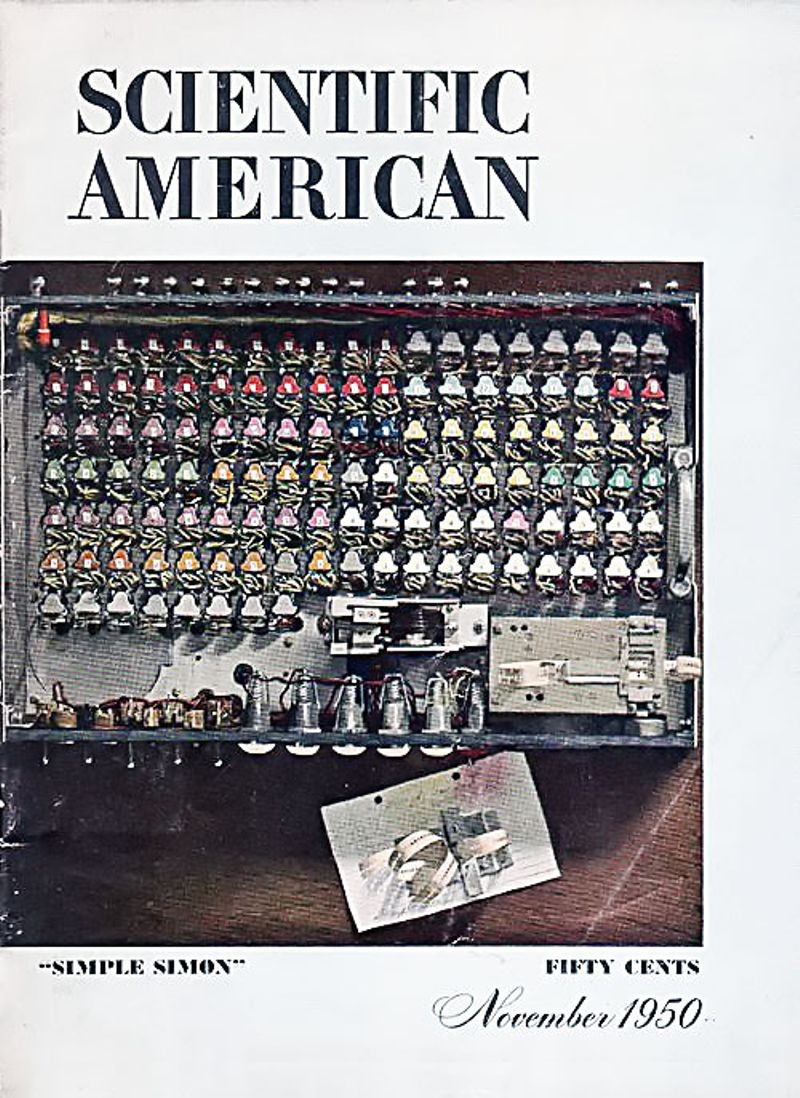
Simon featured on the November 1950 Scientific American cover
Plans to build the Simon 1 relay logic machine are published
The hobbyist magazine Radio Electronics publishes Edmund Berkeley’s design for the Simon 1 relay computer from 1950 to 1951. The Simon 1 used relay logic and cost about $600 to build. In his book Giant Brains, Berkeley noted – “We shall now consider how we can design a very simple machine that will think. Let us call it Simon, because of its predecessor, Simple Simon… Simon is so simple and so small in fact that it could be built to fill up less space than a grocery-store box; about four cubic feet.”
SEAC and SWAC completed
The Standards Eastern Automatic Computer (SEAC) is among the first stored program computers completed in the United States. It was built in Washington DC as a test-bed for evaluating components and systems as well as for setting computer standards. It was also one of the first computers to use all-diode logic, a technology more reliable than vacuum tubes. The world’s first scanned image was made on SEAC by engineer Russell Kirsch in 1957.
The NBS also built the Standards Western Automatic Computer (SWAC) at the Institute for Numerical Analysis on the UCLA campus. Rather than testing components like the SEAC, the SWAC was built using already-developed technology. SWAC was used to solve problems in numerical analysis, including developing climate models and discovering five previously unknown Mersenne prime numbers.
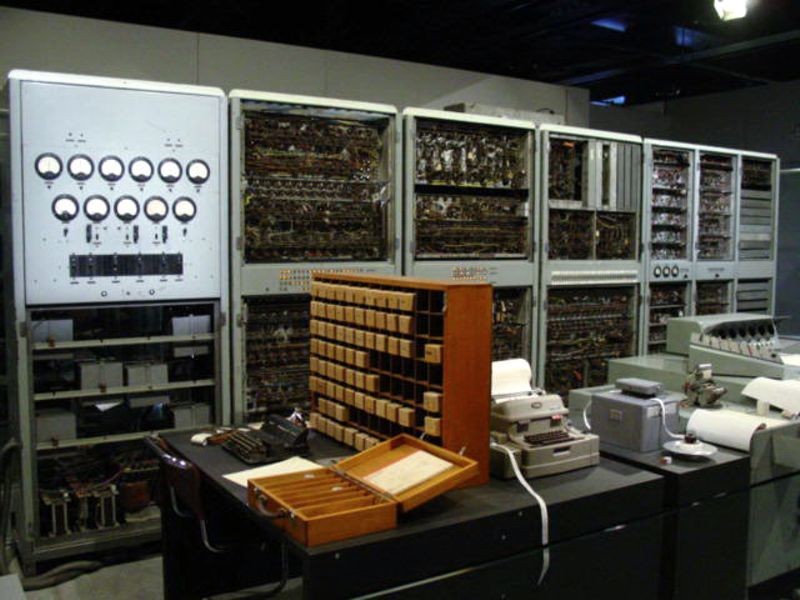
CSIRAC
CSIRAC plays the Colonel Bogey march
Australia’s first computer, the CSIRAC, begins operating in 1949. Chief programmer Geoff Hill came from a musical family and as part of preparations for a demonstration of CSIRAC during the first Australian Conference on Automatic Computing Machines, he programmed it to play several songs, including Colonel Bogey, a popular regimental march written at the beginning World War I.
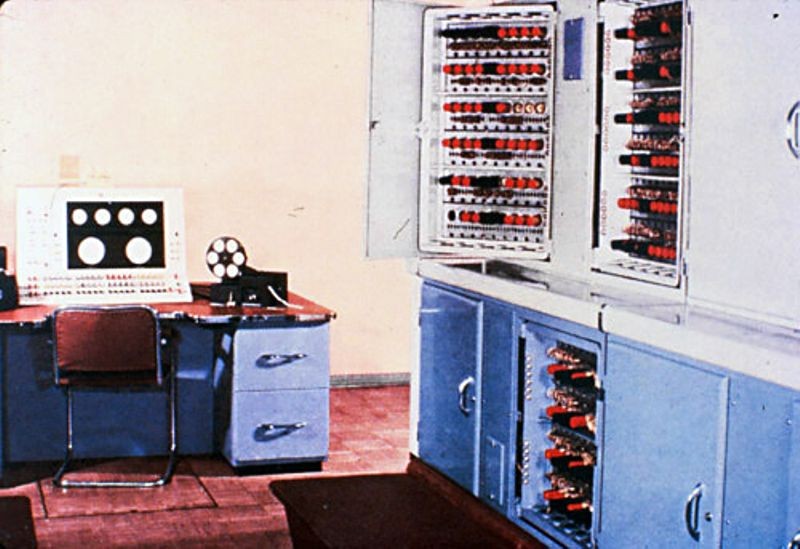
Ferranti Mark 1
Ferranti Mark I sold
The title of “first commercially available general-purpose computer” probably goes to Britain’s Ferranti Mark I for its sale of its first Mark I computer to Manchester University. The Mark 1 was a refinement of the experimental Manchester “Baby” and Manchester Mark 1 computers, also at Manchester University. A British government contract spurred its initial development but a change in government led to loss of funding and the second and only other Mark I was sold at a major loss to the University of Toronto, where it was re-christened FERUT.
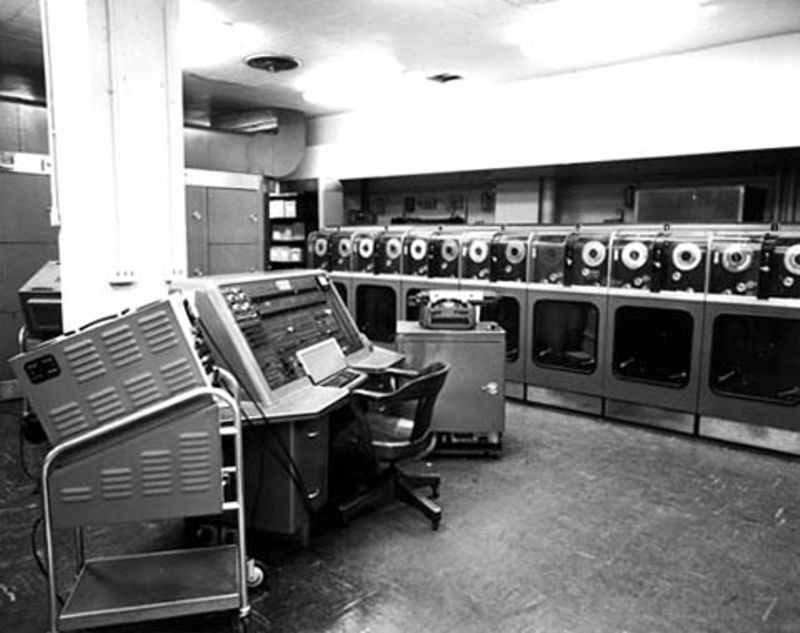
Univac 1 installation
First Univac 1 delivered to US Census Bureau
The Univac 1 is the first commercial computer to attract widespread public attention. Although manufactured by Remington Rand, the machine was often mistakenly referred to as “the IBM Univac.” Univac computers were used in many different applications but utilities, insurance companies and the US military were major customers. One biblical scholar even used a Univac 1 to compile a concordance to the King James version of the Bible. Created by Presper Eckert and John Mauchly — designers of the earlier ENIAC computer — the Univac 1 used 5,200 vacuum tubes and weighed 29,000 pounds. Remington Rand eventually sold 46 Univac 1s at more than $1 million each.
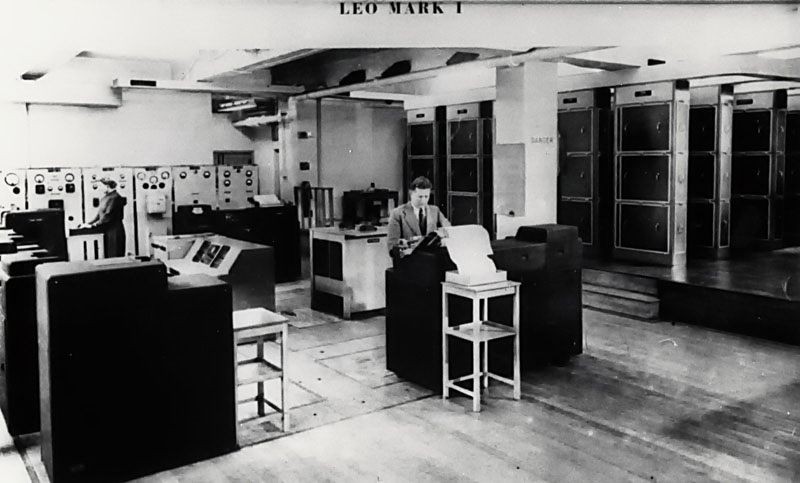
The LEO
J. Lyons & Company introduce LEO-1
Modeled after the Cambridge University EDSAC computer, the president of Lyons Tea Co. has the LEO built to solve the problem of production scheduling and delivery of cakes to the hundreds of Lyons tea shops around England. After the success of the first LEO, Lyons went into business manufacturing computers to meet the growing need for data processing systems in business. The LEO was England’s first commercial computer and was performing useful work before any other commercial computer system in the world.

Nimrod at the Festival of Britain
Nimrod on display at Festival of Britain
The Festival of Britain was designed as a nationwide display of British Arts, Technology and Culture following the widespread destruction of World War II. As a part of the festivities, computer company Ferranti provided a display for the Festival’s activities in South Kensington (London). John Bennett, an Australian employee living in Britain, suggested building a machine to play NIM, a simple game where players take turns removing matches from piles in an attempt to be the last person to remove a match. An electromechanical device to play the game had been on display at the 1939 World’s Fair in New York. Engineer Raymond Stuart-Williams turned Bennet’s design into an actual machine that debuted at the Festival on April 12th, 1951. Ferranti took Nimrod to the Berlin International Show later in 1951, but dismantled it afterwards.
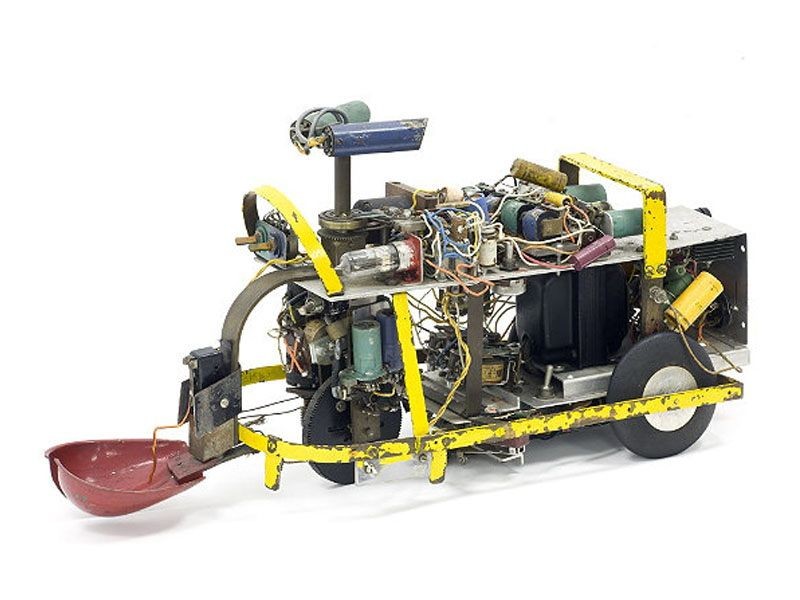
Squee: The Robot Squirrel
Squee: The Robot Squirrel
Squee: The Robot Squirrel uses two light sensors and two contact switches to hunt for ”nuts” (actually, tennis balls) and drag them to its nest. Squee was described as “75% reliable,” but it worked well only in a very dark room. Squee was conceived by computer pioneer Edmund Berkeley, who earlier wrote the hugely popular book Giant Brains or Machines That Think (1949). The original Squee prototype is in the permanent collection of the Computer History Museum.

UNIVAC UNISERVO tape drive
UNIVAC introduces the “UNISERVO” tape drive for the UNIVAC I computer. It was the first tape storage device for a commercial computer, and the relative low cost, portability and unlimited offline capacity of magnetic tape made it very popular. UNIVAC tapes were ½” wide, 0.0015″ thick, up to 1,500′ long, and made of phosphor-bronze with a metallic coating. Weighing about three pounds, each reel could hold 1,440,000 decimal digits and could be read at 100 inches/sec.
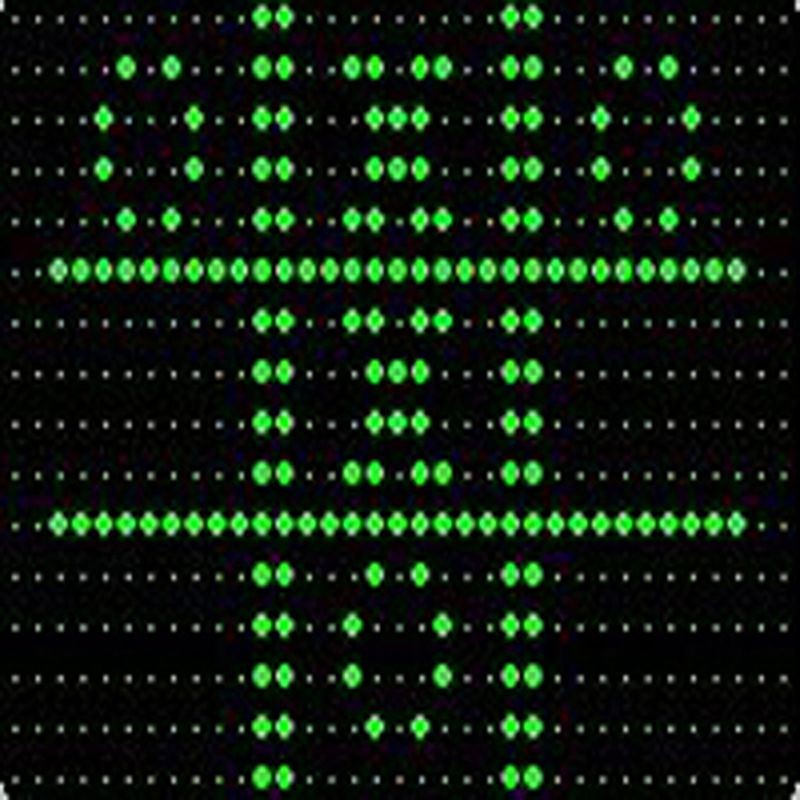
OXO screenshot
Alexander Douglas writes OXO for EDSAC
Alexander Douglas was a Cambridge University PhD candidate when he designed one of the earliest computer games, a version of Tic-Tac-Toe (known in Britain as ‘Naughts and Crosses’), called OXO. Played on Cambridge’s EDSAC computer, OXO allowed a player to choose to start or to allow the machine to make the first move. Using a rotary telephone dial to enter their moves, the EDSAC would display the game board on a 35 x 15 dot cathode ray tube. Few outside of Cambridge ever played OXO.
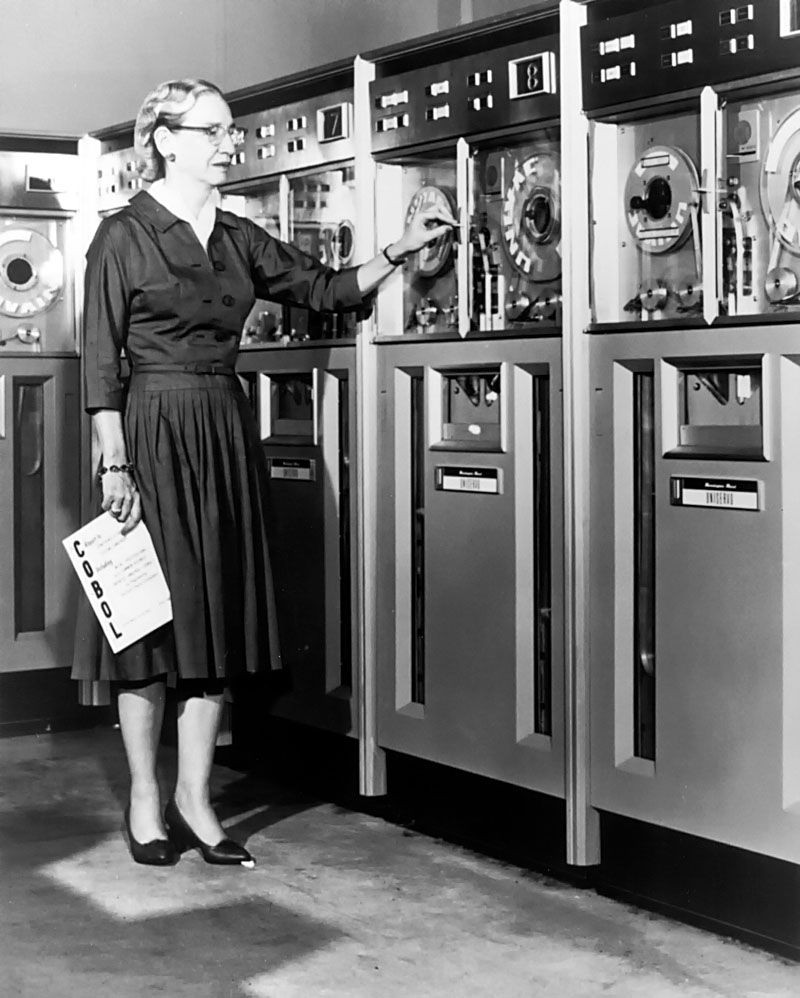
Grace Hopper
Grace Hopper completes A-0
Mathematician Grace Hopper completes A-0, a program that allows a computer user to use English-like words instead of numbers to give the computer instructions. It possessed several features of a modern-day compiler and was written for the UNIVAC I computer, the first commercial business computer system in the United States.
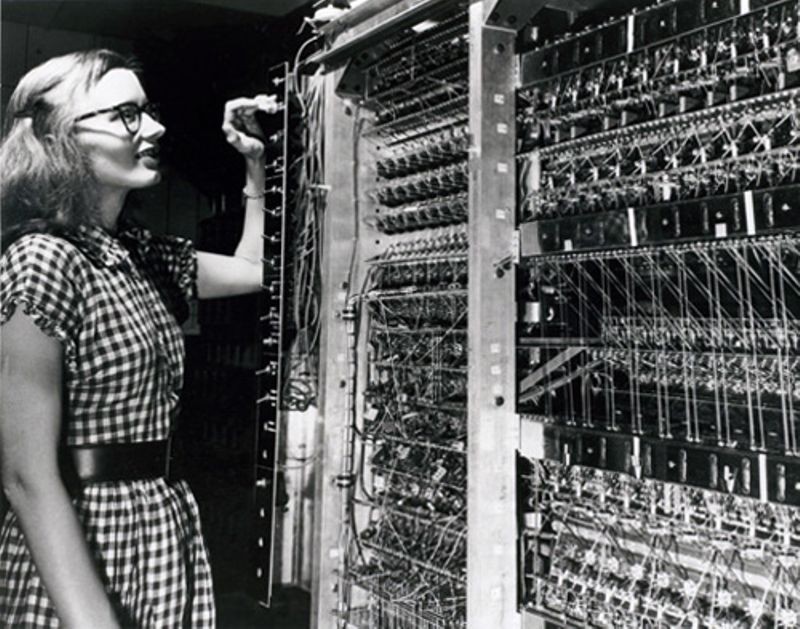
MANIAC at Los Alamos
IAS computer operational
The Institute of Advanced Study (IAS) computer is a multi-year research project conducted under the overall supervision of world-famous mathematician John von Neumann. The notion of storing both data and instructions in memory became known as the ‘stored program concept’ to distinguish it from earlier methods of instructing a computer. The IAS computer was designed for scientific calculations and it performed essential work for the US atomic weapons program. Over the next few years, the basic design of the IAS machine was copied in at least 17 places and given similar-sounding names, for example, the MANIAC at Los Alamos Scientific Laboratory; the ILLIAC at the University of Illinois; the Johnniac at The Rand Corporation; and the SILLIAC in Australia.
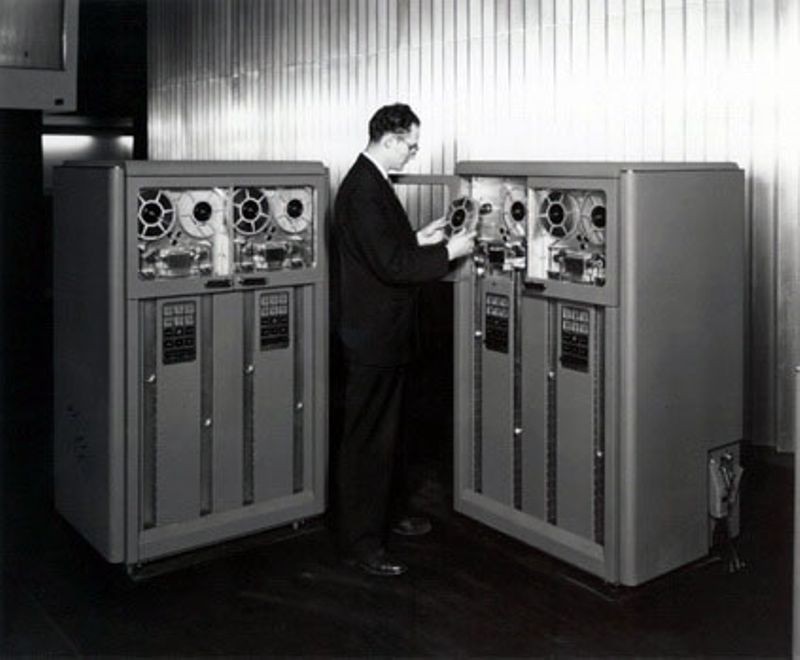
IBM 726 dual tape drive
IBM 726 Magnetic tape
Magnetic tape allows for inexpensive mass storage of information and is a key part of the computer revolution. The IBM 726 was an early and important practical high-speed magnetic tape system for electronic computers. Announced on May 21, 1952, the system used a unique ‘vacuum channel’ method of keeping a loop of tape circulating between two points, allowing the tape drive to start and stop the tape in a split-second. The Model 726 was initially sold in 1953 with IBM’s first electronic digital computer, the Model 701, and could store 2 million digits per tape—an enormous amount at the time. The 726 rented for $850 a month.

Cronkite with UNIVAC
UNIVAC computer predicts election
On election night, November 4, CBS News borrows a UNIVAC computer to predict the outcome of the race for the US presidency between Dwight D. Eisenhower and Adlai Stevenson. Opinion polls predicted strong support for Stevenson, but the UNIVAC´s analysis of early returns showed a clear victory for Eisenhower. This sharp divergence from public opinion made UNIVAC executives question the validity of the computer´s forecast, so announcers Walter Cronkite and Charles Collingwood postponed announcing UNIVAC´s correct prediction until very late in the broadcast.
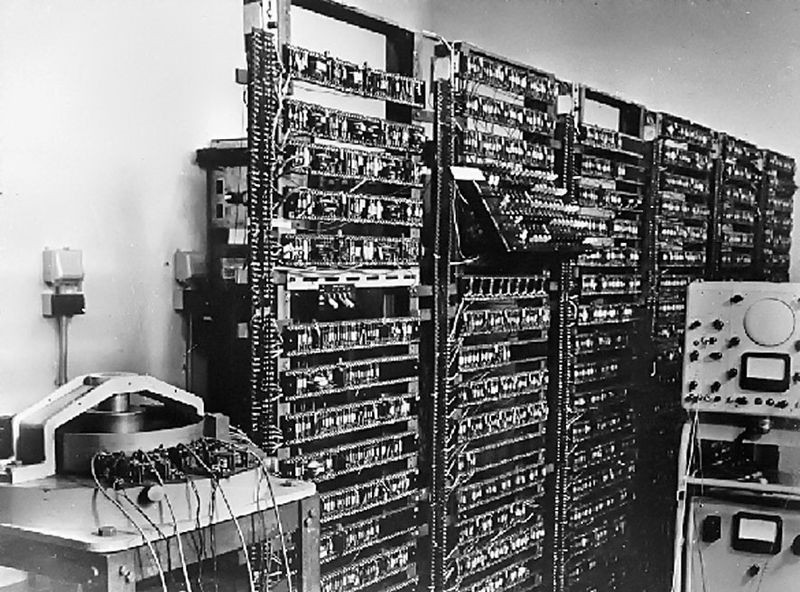
Manchester transistorized computer
Grimsdale and Webb build early transistorized computer
Working under Tom Kilburn at England’s Manchester University, Richard Grimsdale and Douglas Webb demonstrate a prototype transistorized computer, the “Manchester TC”, on November 16, 1953. The 48-bit machine used 92 point-contact transistors and 550 diodes.
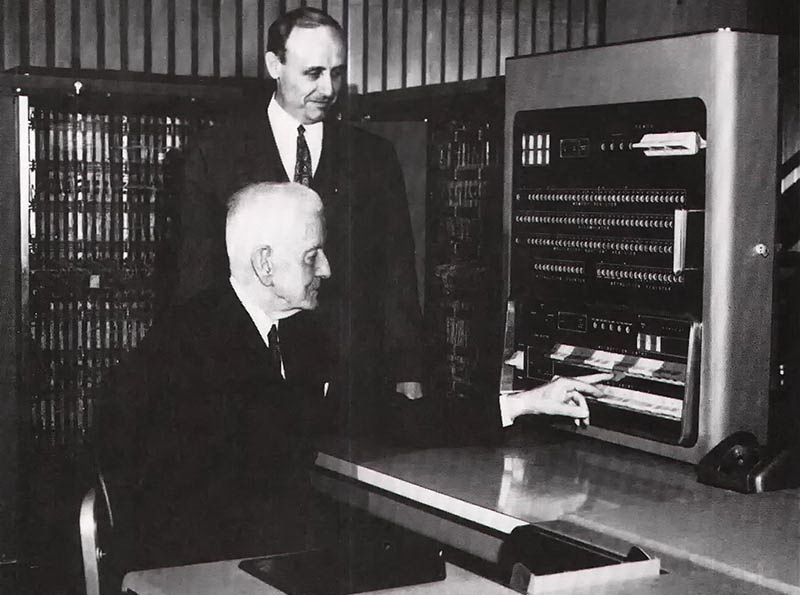
Cuthbert Hurd (standing) and Thomas Watson, Sr. at IBM 701 console
IBM ships its Model 701 Electronic Data Processing Machine
During three years of production, IBM sells 19 701s to research laboratories, aircraft companies, and the federal government. Also known inside IBM as the “Defense Calculator,” the 701 rented for $15,000 a month. Programmer Arthur Samuels used the 701 to write the first computer program designed to play checkers. The 701 introduction also marked the beginning of IBM’s entry into the large-scale computer market, a market it came to dominate in later decades.
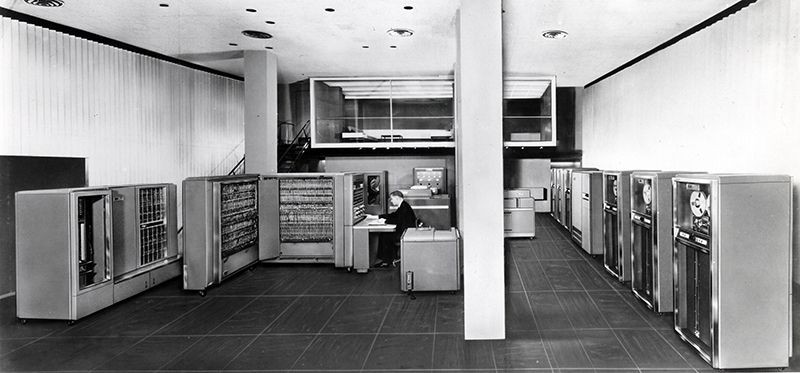
IBM 701, the Defense Calculator
John Backus completes Speedcode
John Backus completes Speedcode for IBM´s first large-scale scientific computer, the IBM 701. Although using Speedcode demanded a significant amount of scarce memory, it greatly reduced the time required to write a program. In 1957, Backus became project leader of the IBM FORTRAN project, which became the most popular scientific programming language in history and is still in use today.
RAND Corporation completes Johnniac computer
The Johnniac computer is one of 17 computers that followed the basic design of Princeton’s Institute of Advanced Study (IAS) computer. It was named after John von Neumann, a world famous mathematician and computer pioneer of the day. Johnniac was used for scientific and engineering calculations. It was also repeatedly expanded and improved throughout its 13-year lifespan. Many innovative programs were created for Johnniac, including the time-sharing system JOSS that allowed many users to simultaneously access the machine.
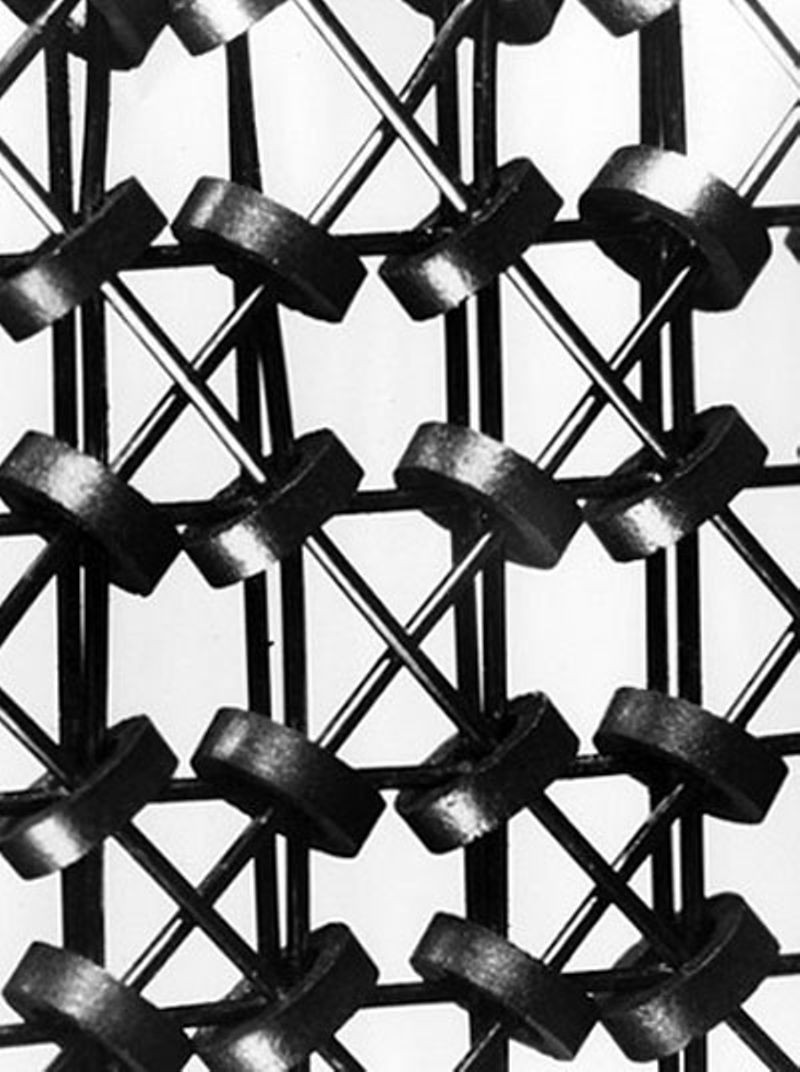
Detail of Whirlwind core memory
Whirlwind core memory
In 1953, MIT’s Whirlwind becomes the first computer to use magnetic core memory. Core memory is made up of tiny “donuts” made of magnetic material strung on wires into a grid. Each core stored a bit, magnetized one way for a “zero,” and the other way for a “one.” The wires could both detect and change the state of a bit. Though several inventors were involved, it was MIT’s Jay Forrester who perfected the technology. In 1971, the introduction of the Intel 1103 DRAM integrated circuit signaled the beginning of the end for magnetic core memory in computers.
Alan Turing is found dead at age 42
English mathematician Alan Turing is found dead in his bed with a cyanide-laced apple on his night stand. Turing had published a seminal paper, On Computable Numbers, in 1936 in which he theorized about the nature of human and machine intelligence. During World War II, Turing applied his mathematical genius to codebreaking efforts, including solving the riddle of the German ENIGMA encryption machine.
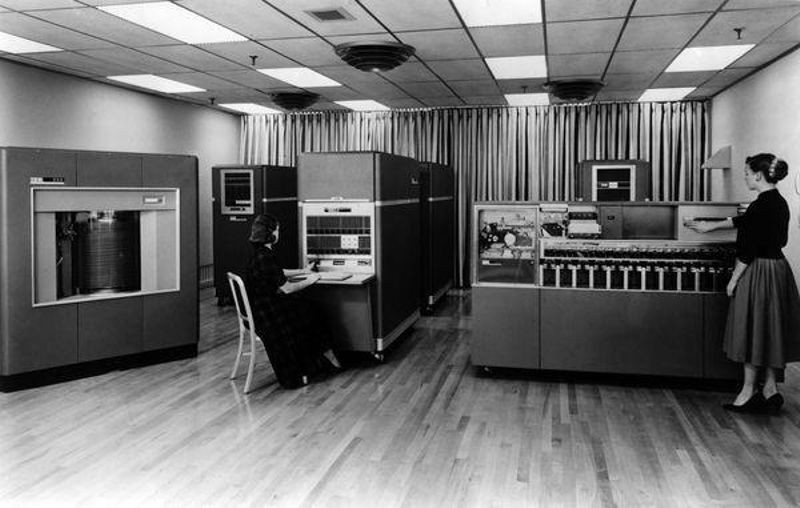
IBM 650
IBM 650 magnetic drum calculator introduced
IBM establishes the 650 as its first mass-produced computer, with the company selling 450 in just one year. Spinning at 12,500 rpm, the 650´s magnetic data-storage drum allowed much faster access to stored information than other drum-based machines. The Model 650 was also highly popular in universities, where a generation of students first learned programming.
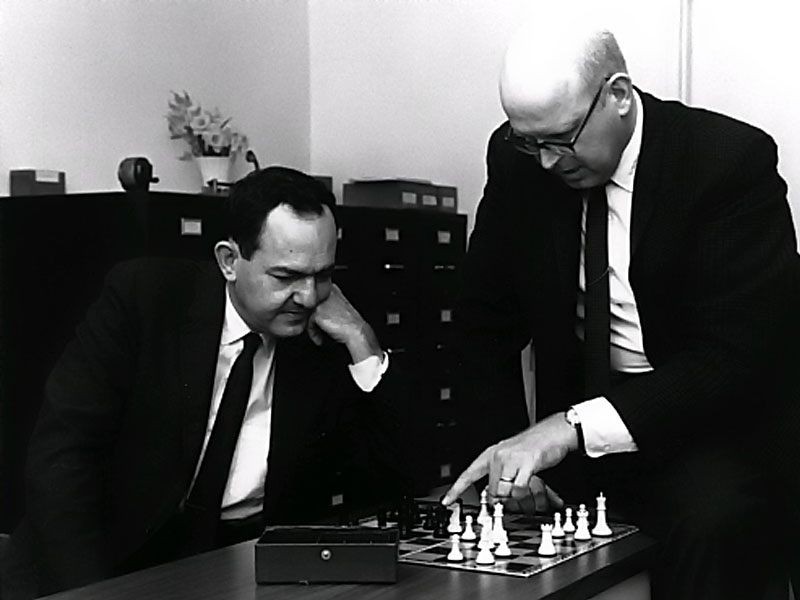
Herb Simon (L) and Allen Newell (R)
Logic Theorist
Allen Newell, Herbert A. Simon and J.C. Shaw begin work on Logic Theorist, a program that would eventually prove 38 theorems from Whitehead and Russell’s Principia Mathematica. Logic Theorist introduced several critical concepts to artificial intelligence including heuristics, list processing and ‘reasoning as search.’
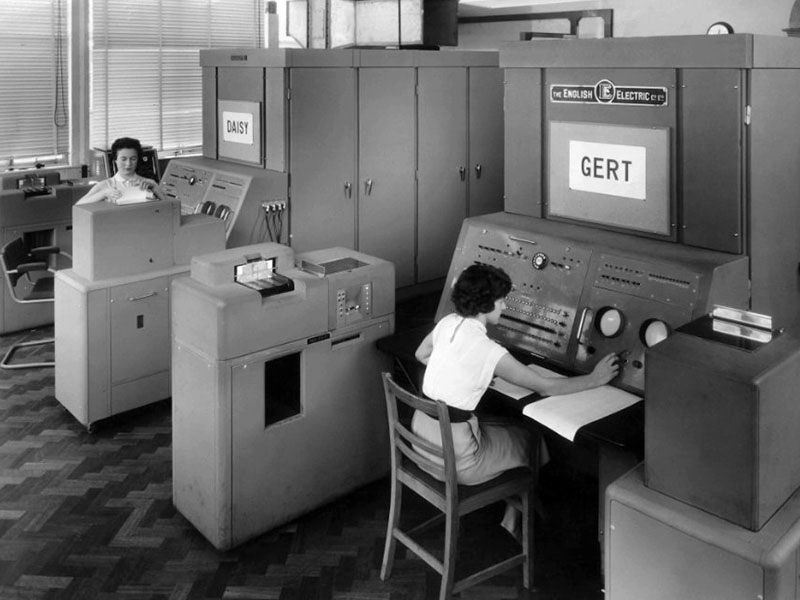
English Electric DEUCE
English Electric DEUCE introduced
A commercial version of Alan Turing’s Pilot ACE, called DEUCE—the Digital Electronic Universal Computing Engine — is used mostly for science and engineering problems and a few commercial applications. Over 30 were completed, including one delivered to Australia.
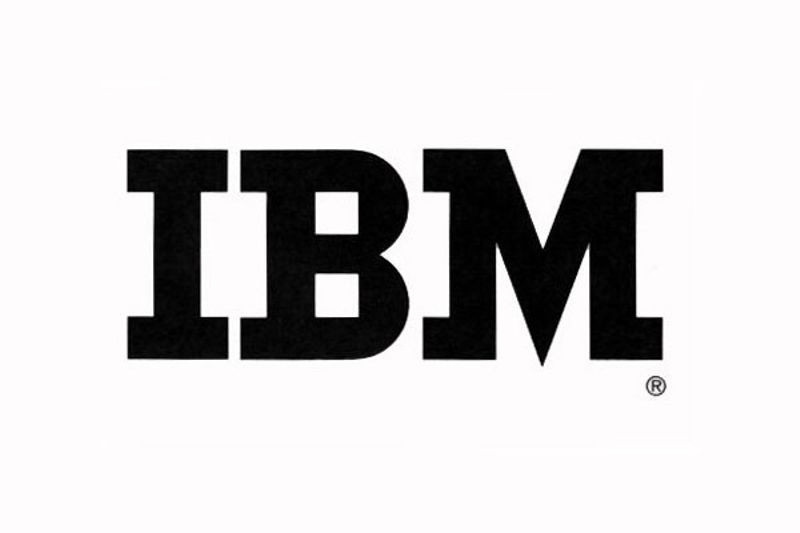
IBM logo, ca. 1956
First meeting of IBM users group SHARE
In the early days of commercial computers in the early to mid-1950s, IBM’s support for its customers is felt by many to be insufficient. The SHARE group was a means to exchange technical details about IBM computers among its users, in part to fill this perceived gap. SHARE was particularly known for its boisterous meetings and close cooperation among competitors seeking to deploy computers in their companies.
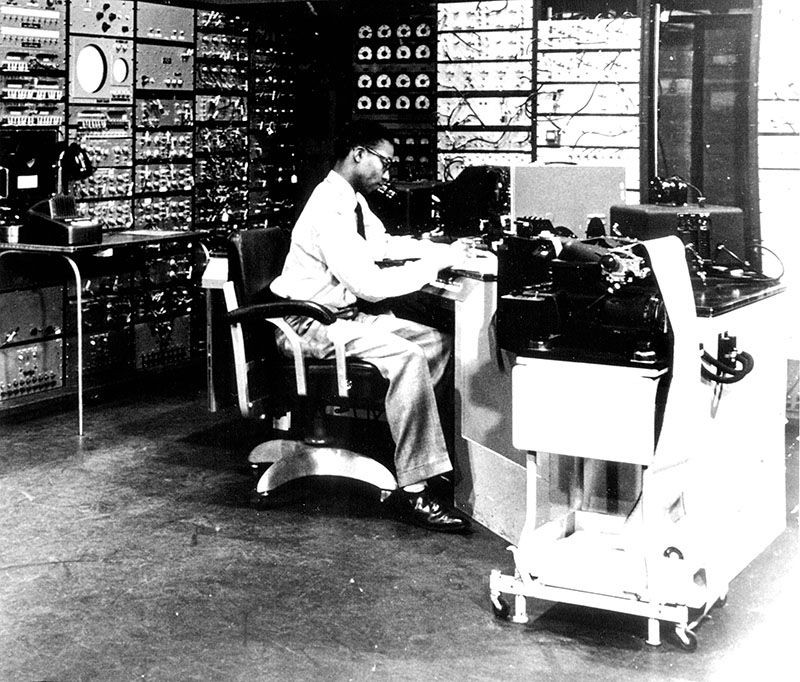
Joe Thompson at Whirlwind console, ca. 1951
Direct keyboard input to computers
At MIT, researchers begin experimenting with direct keyboard input to computers, a precursor to today´s normal mode of operation. Typically, computer users of the time fed their programs into a computer using punched cards or paper tape. Doug Ross wrote a memo advocating direct access in February. Ross contended that a Flexowriter — an electrically-controlled typewriter — connected to an MIT computer could function as a keyboard input device due to its low cost and flexibility. An experiment conducted five months later on the MIT Whirlwind computer confirmed how useful and convenient a keyboard input device could be.

Computer Music featuring the Illiac Suite
Lejaren Hiller and Leonard Isaacson complete the Illiac Suite
Created using the Illiac I computer at the University of Illinois, Urbana-Champaign, the Illiac Suite is one of the earliest pieces of music composed using an electronic computer. The piece consisted of four musical “experiments” for string quartet, each comprised of two parts. Hiller founded the Experimental Music Center at the University of Illinois in 1958.
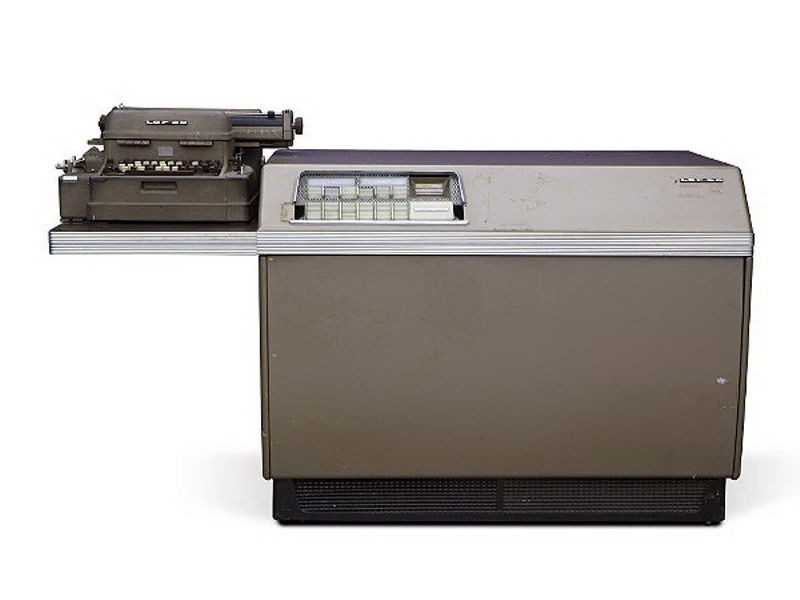
LGP-30
Librascope LGP-30 introduced
Physicist Stan Frankel, intrigued by small, general-purpose computers, developed the MINAC at Caltech. The Librascope division of defense contractor General Precision buys Frankel’s design, renaming it the LGP-30 in 1956. Used for science and engineering as well as simple data processing, the LGP-30 was a “bargain” at less than $50,000 and an early example of a ‘personal computer,’ that is, a computer made for a single user.
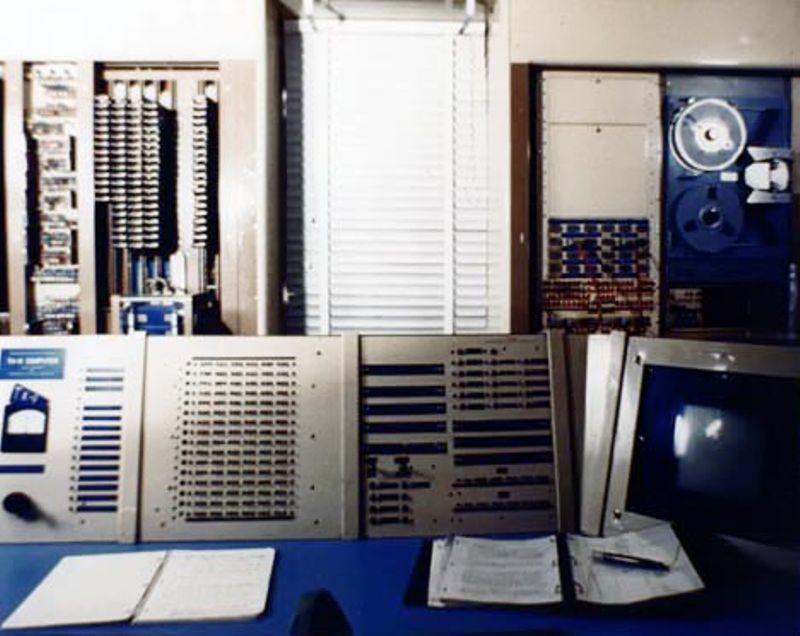
TX-0 at MIT
MIT researchers build the TX-0
The TX-0 (“Transistor eXperimental – 0”) is the first general-purpose programmable computer built with transistors. For easy replacement, designers placed each transistor circuit inside a “bottle,” similar to a vacuum tube. Constructed at MIT´s Lincoln Laboratory, the TX-0 moved to the MIT Research Laboratory of Electronics, where it hosted some early imaginative tests of programming, including writing a Western movie shown on television, 3-D tic-tac-toe, and a maze in which a mouse found martinis and became increasingly inebriated.

RAMAC 305 disks and head assembly
RAMAC
The era of magnetic disk storage dawns with IBM´s shipment of a RAMAC 305 computer system to Zellerbach Paper in San Francisco. The computer was based on the new technology of the hard disk drive — the world’s first. The RAMAC disk drive consisted of 50 magnetically coated metal platters capable of storing about 5 million characters of data. RAMAC allowed real-time random access to large amounts of data, unlike magnetic tape or punched cards. A working RAMAC hard disk assembly is demonstrated regularly at the Computer History Museum.
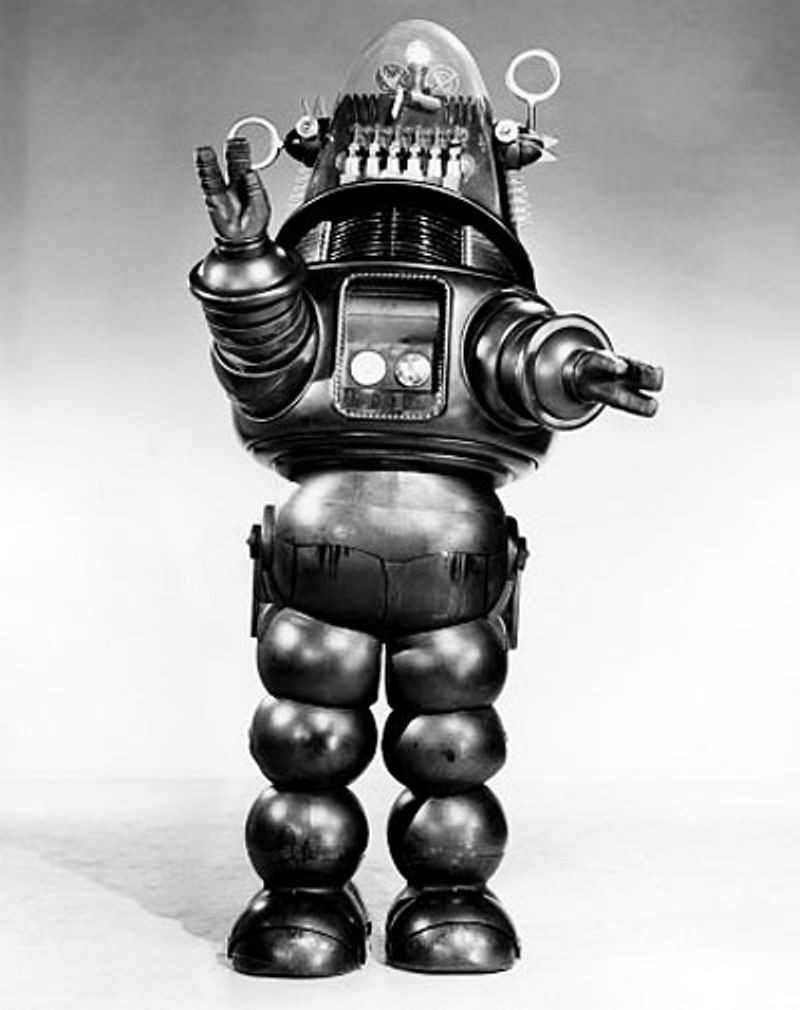
Robby the Robot
Robby the Robot
Robby the Robot appears in MGM’s 1956 science fiction movie Forbidden Planet. In the film, Robby was the creation of Dr. Morbius and was built to specifications found in an alien computer system. Robby’s duties included assisting the human crew while following Isaac Asimov’s Three Laws of Robotics (1941). The movie was a cult hit, in part because of Robby’s humorous personality and Robby the Robot toys became huge sellers.
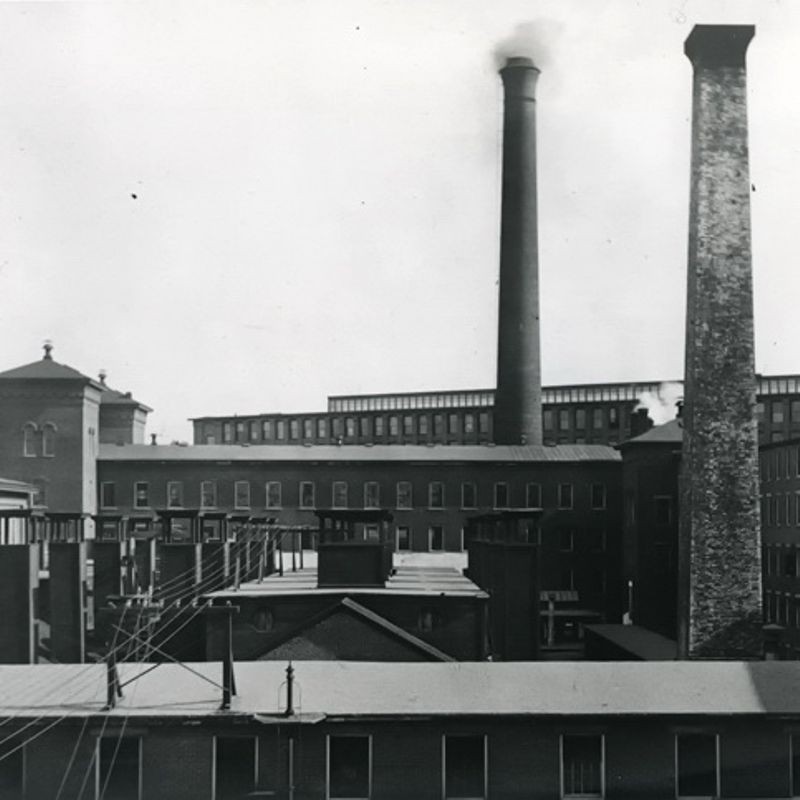
The Maynard mill
Digital Equipment Corporation (DEC) founded
DEC is founded initially to make electronic modules for test, measurement, prototyping and control markets. Its founders were Ken and Stan Olsen, and Harlan Anderson. Headquartered in Maynard, Massachusetts, Digital Equipment Corporation, took over 8,680 square foot leased space in a nineteenth century mill that once produced blankets and uniforms for soldiers who fought in the Civil War. General Georges Doriot and his pioneering venture capital firm, American Research and Development, invested $70,000 for 70% of DEC’s stock to launch the company in 1957. The mill is still in use today as an office park (Clock Tower Place) today.
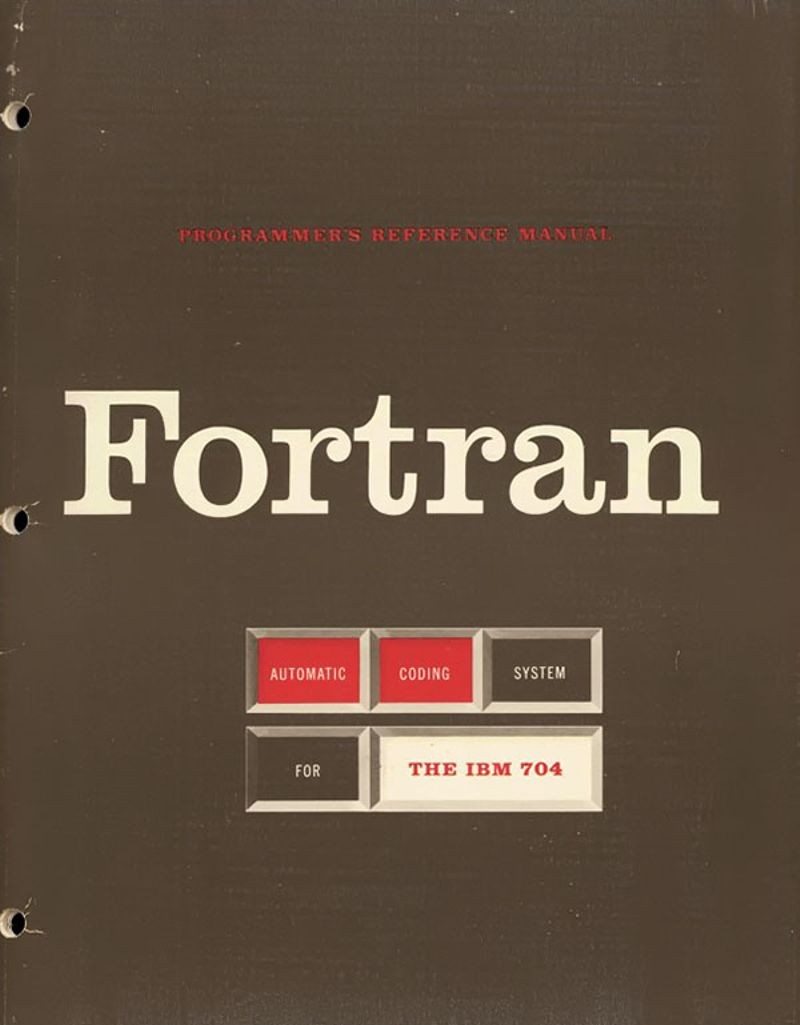
Fortran manual for the IBM 704
FORTRAN
An IBM team led by John Backus develops FORTRAN, a powerful scientific computing language that uses English-like statements. Some programmers were skeptical that FORTRAN could be as efficient as hand coding, but that sentiment disappeared when FORTRAN proved it could generate efficient code. Over the ensuing decades, FORTRAN became the most often used language for scientific and technical computing. FORTRAN is still in use today.
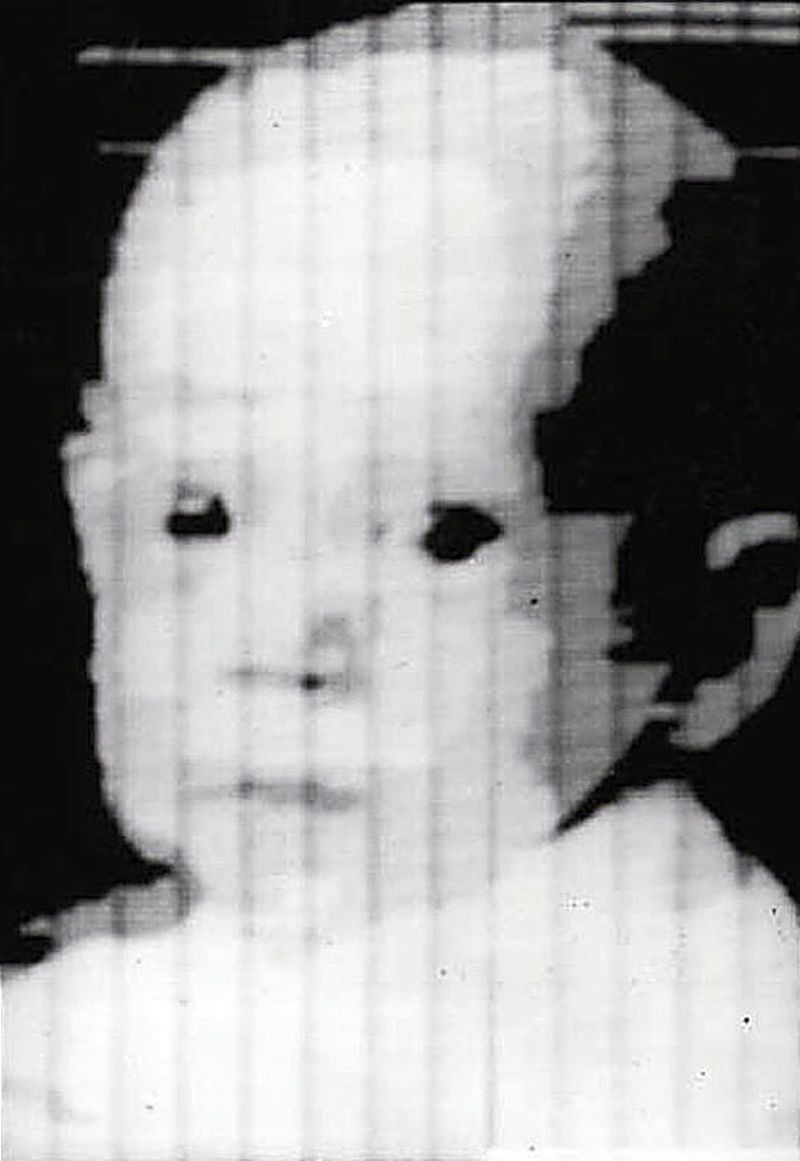
Walden Kirsch, aged 3 months
First computer scanned image on SEAC
One of the earliest applications of computers to image creation and processing starts with the work of Russell Kirsch on the Standards Eastern Automatic Computer (SEAC) in 1957. Working with the SEAC team, Kirsch designed a rotating drum scanner, allowing him to digitize an image of his young son, Walden. The image, a five-by-five centimeter black-and-white shot, was the first image to be scanned into a computer. In 2003, Life Magazine noted it as one of the “100 Photographs that changed the world.”
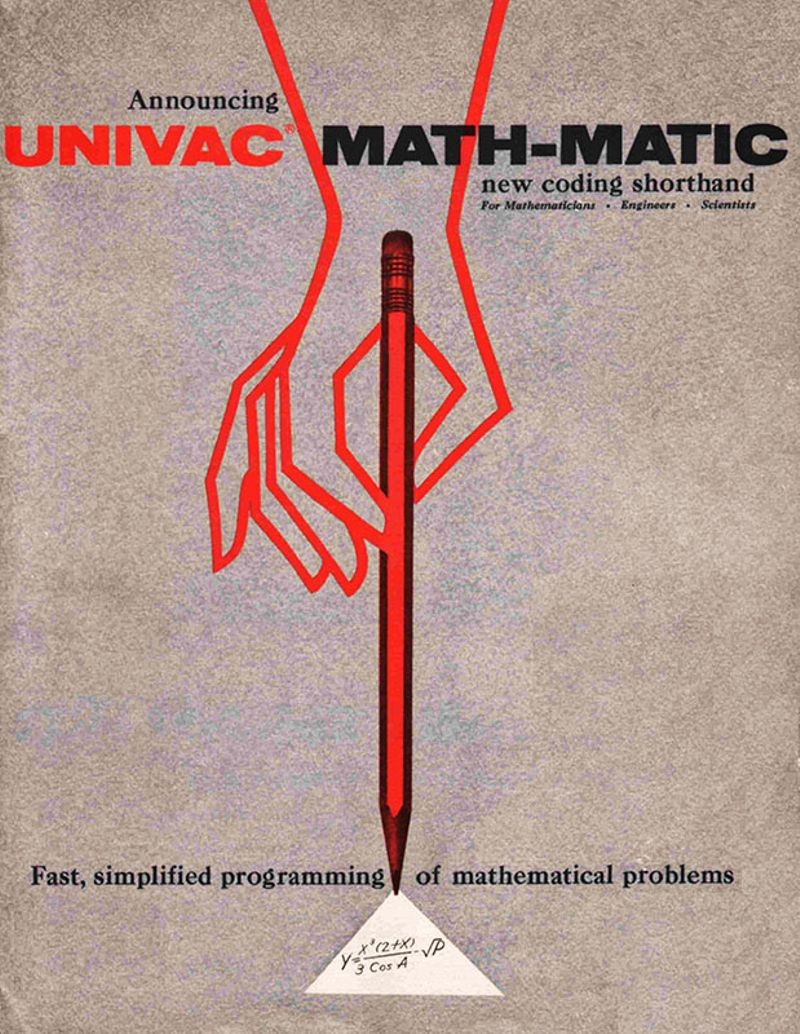
Univac Math-Matic promotional brochure
MATH-MATIC
Sperry Rand releases a commercial compiler for its UNIVAC I computer. Developed by programmer Grace Hopper as a refinement of her earlier innovation, the A-0 compiler, the new version was called MATH-MATIC. Earlier work on the A-0 and A-2 compilers led to the development of the first English-language business data processing compiler, B-0 (FLOW-MATIC), also completed in 1957.
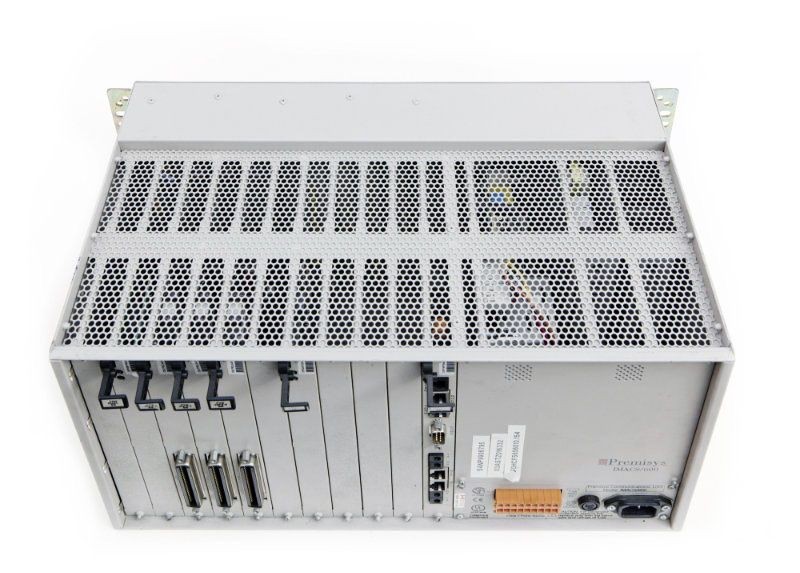
1980s Channel Bank for bringing T1 lines into a business
Digital Phone Lines
Phone companies develop digital transmission for internal uses – specifically to put more calls on each of the main lines connecting their own switching centers. By 1958, this produces the T1 standard still used in North America. By the 1980s, phone companies will be leasing digital lines to commercial customers.
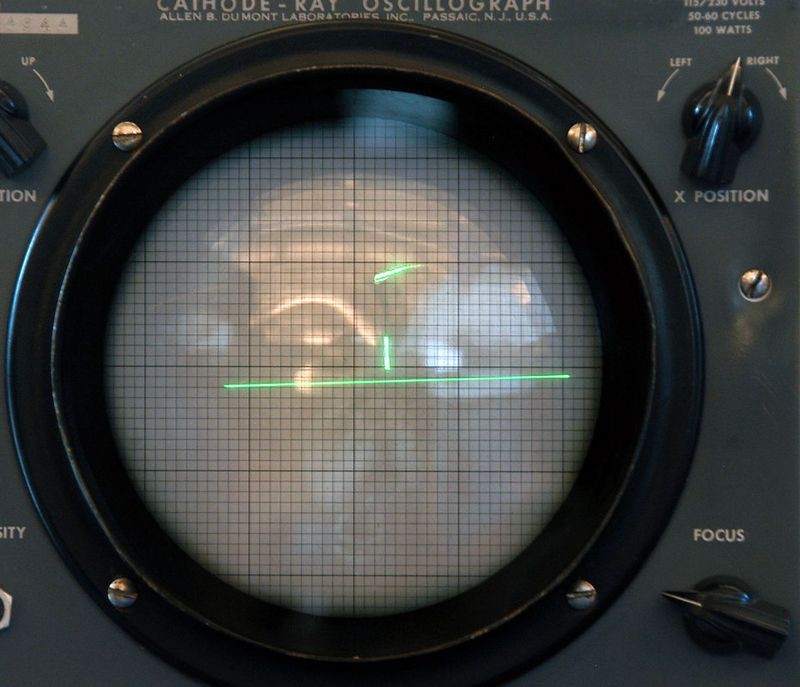
Re-creation, Tennis for Two
Higinbotham develops Tennis-For-Two at Brookhaven National Labs
Brookhaven National Laboratory in Long Island, New York holds an annual “Visitor’s Day” for families and area residents. William Higinbotham, looking for a way to entertain visitors, conceived of a simple electronic game that could be played using the lab’s Donner Model 30 analog computer connected to an oscilloscope display. Working with David Potter, Higinbotham’s creation allowed two players to play a game of ‘tennis’ on the oscilloscope screen, with simple physics for the ball, and even a sound whenever the ball was contacted.
Tennis-for-Two was only used for two years before being salvaged for parts. It only became widely known following Higinbotham’s testimony in a trial over the video game Pong.
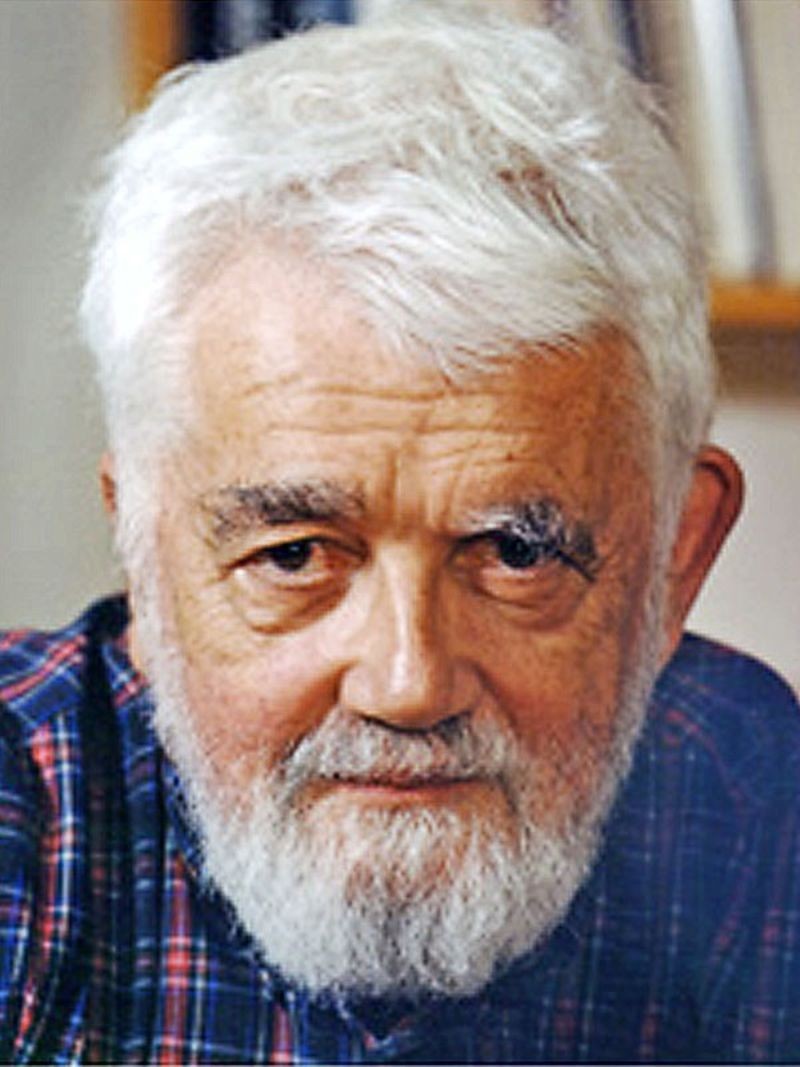
John McCarthy
LISP
The programming language LISP (short for “List Processing”) is invented in 1958 by John McCarthy at MIT. A key feature of LISP was that data and programs were simply lists in parentheses, allowing a program to treat another program – or itself – as data. This characteristic greatly eased the kind of programming that attempted to model human thought. LISP is still used in a large number of artificial intelligence applications.
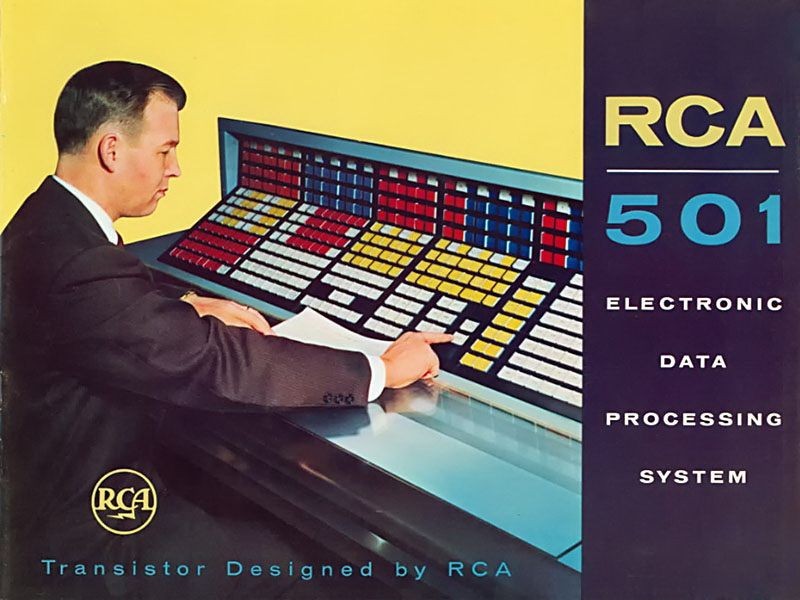
RCA 501 brochure cover
RCA introduces its Model 501 transistorized computer
The 501 is built on a ‘building block’ concept which allows it to be highly flexible for many different uses and could simultaneously control up to 63 tape drives—very useful for large databases of information. For many business users, quick access to this huge storage capability outweighed its relatively slow processing speed. Customers included US military as well as industry.

SAGE console, late 1950s
SAGE Air Defense System: Network Pioneer
Designed to detect Russian nuclear bombers, the IBM-built SAGE (Semi-Automatic Ground Environment) pioneers many technologies including a special-purpose form of networking. There are 23 computer centers across North America, communicating with radar stations, counter-attack aircraft, and each other — all in real-time, as potentially threatening events are happening.
Besides networking SAGE also helps pioneer interactive computing and multi-user systems. Hundreds of people use the system simultaneously, interacting through groundbreaking graphical consoles. Each console has its own large screen, pointing device (a light gun), a telephone, and an ashtray. Ever on the alert for a Soviet attack, SAGE operators would describe the experience as endless hours of boredom…broken by seconds of sheer terror. By the early 1960s, intercontinental ballistic missiles (ICBMs) will make the bomber threat – and SAGE itself – partly obsolete. But the system will operate until the 1980s.
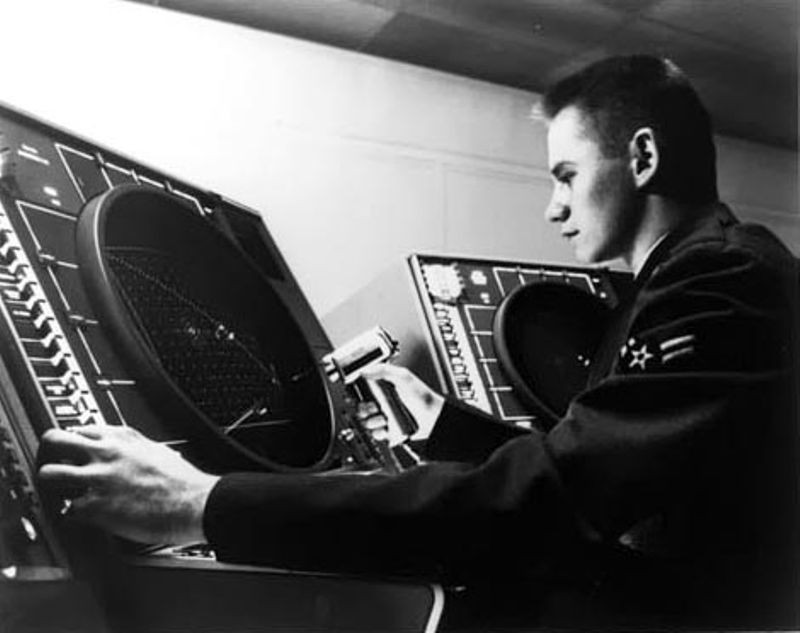
SAGE Operator Station
SAGE system goes online
The first large-scale computer communications network, SAGE connects 23 hardened computer sites in the US and Canada. Its task was to detect incoming Soviet bombers and direct interceptor aircraft to destroy them. Operators directed actions by touching a light gun to the SAGE airspace display. The air defense system used two AN/FSQ-7 computers, each of which used a full megawatt of power to drive its 55,000 vacuum tubes, 175,000 diodes and 13,000 transistors.
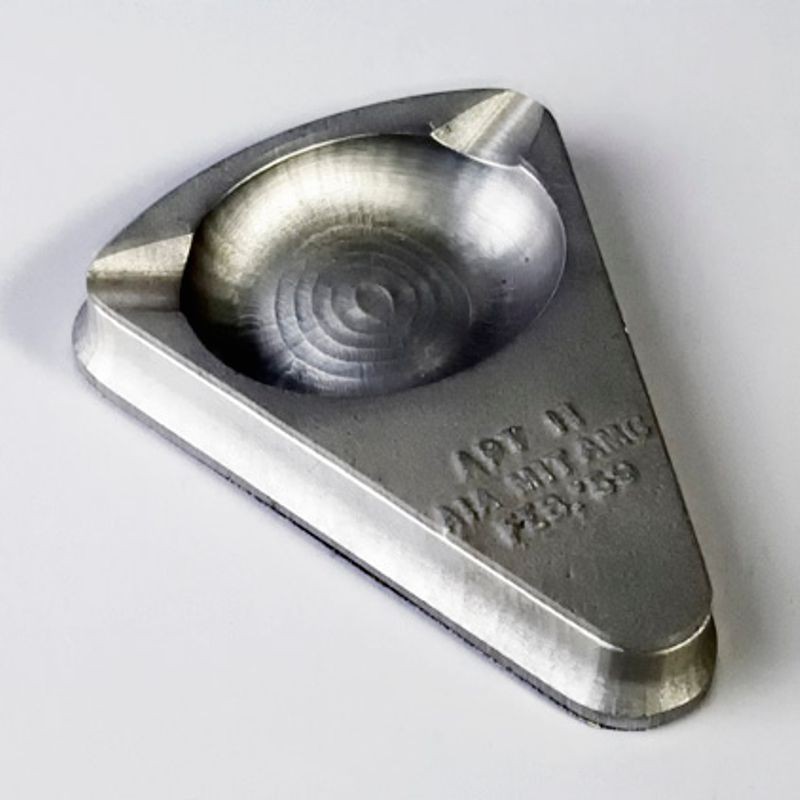
APT ashtray
Automatically Programmed Tools (APT)
MIT´s Servomechanisms Laboratory demonstrates computer assisted manufacturing (CAM). The school´s Automatically Programmed Tools project created a language, APT, used to control milling machine operations. At the demonstration, an air force general claimed that the new technology would enable the United States to “build a war machine that nobody would want to tackle.” The machine produced a commemorative ashtray for each attendee.
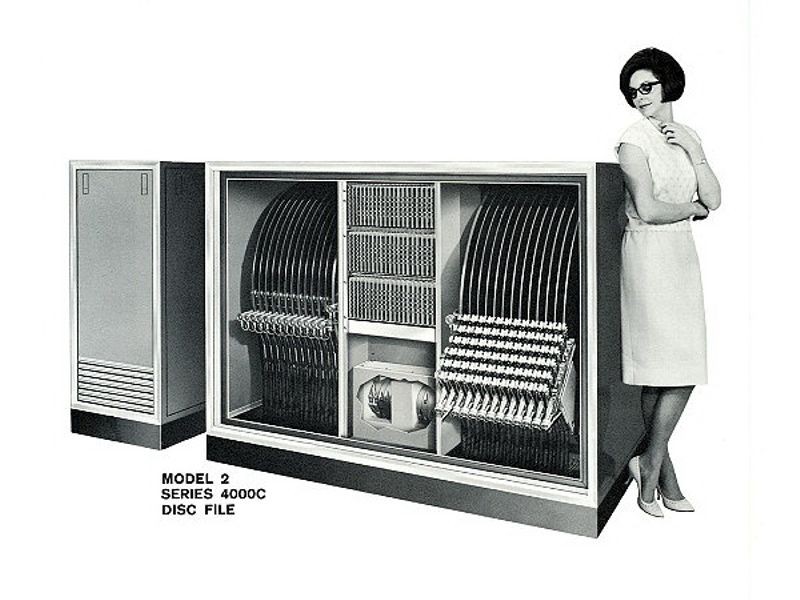
Bryant Chucking Grinder Company magnetic disk drive
Bryant Chucking Grinder Company magnetic disk drive
Bryant Chucking Grinder Company, a computer drum manufacturer, explores new storage ideas. They began developing a disk drive in 1959—made up of a horizontal shaft with eight or more 39-inch magnesium disks. Few sold.

Ted Nelson
Computerizing a “World Brain”
In the 1950s several visionaries including Ted Nelson and Douglas Engelbart independently suggest computerizing the concept of cross-references, creating the clickable link we use on the Web. Nelson calls it a “hyperlink,” and the computerized text “hypertext.” Along with graphics pioneer Andries van Dam they develop many core computing functions such as word processing, online collaboration, and hypertext links. J.C.R. Licklider’s 1960 book Libraries of the Future outlines a related vision, which adds mild artificial intelligence to the mix.
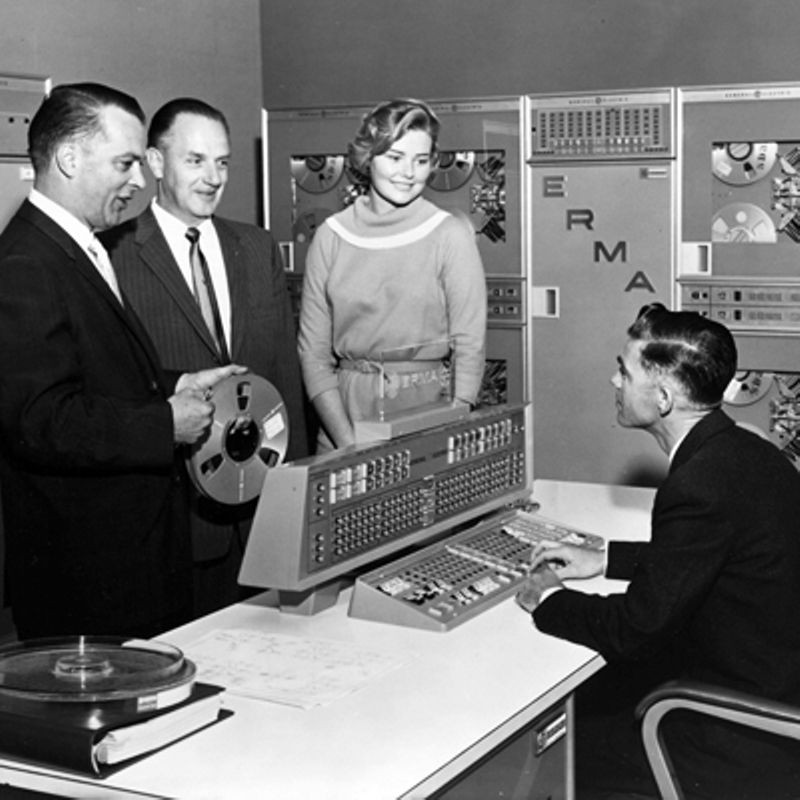
ERMA, the first machine to use Magnetic Ink Character Recognition (MICR)
SRI designs ERMA
SRI International designs ERMA (Electronic Recording Machine, Accounting), for Bank of America. At the time, accounts were posted manually, a method that would quickly be outstripped by the growth in check writing after World War II. The ERMA project digitized checking by creating a computer-readable font. A special scanner read account numbers preprinted on checks using magnetic ink character recognition. In just one hour, ERMA could process the number of accounts that would have taken a well-trained banker nearly 17 workdays to complete.

